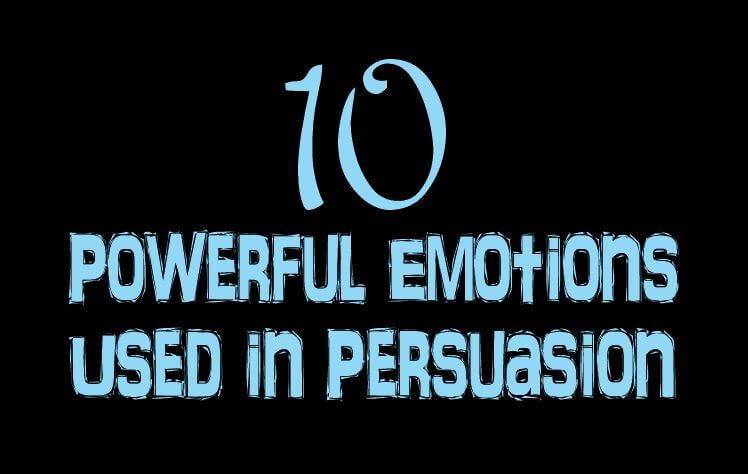Last updated on June 10th, 2025 at 02:30 pm
Emotions possess an incredible power to influence and guide human behaviour. Discover these 10 powerful emotions used in persuasion.
From the ancient art of rhetoric to modern-day advertising and marketing strategies, understanding and tapping into emotions has been a key component of effective persuasion.
In the realm of persuasion, certain emotions hold exceptional sway over our decision-making processes, motivating us to take action, change opinions, or adopt new beliefs.
These ten powerful emotions, when skillfully employed, can be harnessed to sway minds and win hearts.
To understand the mechanics of emotions and all the fundamental dynamics read this dedicated post – How Emotions Shape Thoughts and Behaviours.
Table of Contents
-
10 Emotions Used in Persuasion
- 1. Fear as a Tool for Persuasion
- 2. Guilt as a Tool for Persuasion
- 3. Anger as a Tool for Persuasion
- 4. Excitement as a Tool for Persuasion
- 5. Empathy as a Tool for Persuasion
- 6. Trust as a Tool for Persuasion
- 7. Happiness as a Tool for Persuasion
- 8. Curiosity as a Toll for Persuasion
- 9. Hope as a Tool for Persuasion
- 10. Shame as a Tool for Persuasion
- Conclusion
10 Emotions Used in Persuasion
Here are human emotions and how they are used for persuasion:
1. Fear as a Tool for Persuasion

Fear is a commonly used tactic in persuasion as it aims to make people act or think a certain way out of fear of negative consequences.
For example, politicians may use fear to persuade people to vote for them by instilling fear of what would happen if the opposing party were to win.
Advertisements may use fear to sell products by depicting the negative consequences of not using their product.
Fear can also be used to motivate behavior, such as wearing a seatbelt while driving, by reminding people of the potential dangers and consequences of not doing so.
Overall, fear is a powerful emotion that can be manipulated to influence the thoughts and actions of individuals.
Related: Overcoming the Obstacles to Self Mastery
2. Guilt as a Tool for Persuasion

You must have heard about the phrase “guilt trip”. It means to make someone feel guilty and therefore vulnerable.
Guilt is often used as a persuasive tool to influence a person’s thoughts and behaviors.
Guilt implies that a person has done something wrong or failed to meet a certain expectation, and it is often associated with negative emotions such as regret, shame, and disappointment.
To use guilt for persuasion, a person or organization may try to make an individual feel responsible for certain actions or outcomes, even if they are not directly responsible.
For example, an environmental advocacy group might use guilt to persuade people to recycle more by highlighting the negative impact that waste has on the environment and making individuals feel guilty for contributing to that harm.
Related: Emotional Persuasion: Using Emotional Power For Persuasion
Similarly, in personal relationships, guilt can be used to influence behavior by making someone feel bad for not meeting a certain standard or expectation.
For example, a friend might use guilt to persuade someone to attend a party they don’t want to go to by pointing out how much effort they have put into organizing it and how disappointed they will be if the individual doesn’t show up.
In political campaigns, guilt can also be used to persuade people to vote a certain way or support a particular cause. Often, political ads will portray a certain issue as one in which individuals are personally responsible for making a change, and they use guilt to encourage people to take action.
Guilt can be a powerful persuasive tool, but it can also be manipulative and emotionally distressing.
It is crucial for individuals to critically evaluate the motivations behind guilt-based persuasion and make decisions that align with their values and beliefs.
Recommended: Why it’s Difficult to Beat Smart People in an Argument
3. Anger as a Tool for Persuasion

Anger has been a popular tool used to persuade people into doing something.
It can be effective in certain situations as it stimulates people to take some form of action and may make them more receptive to the speaker’s message.
Some individuals tend to use anger as a form of aggression when trying to convince others to adopt their point of view.
However, it is important to note that using anger alone without any logical arguments and facts to support one’s position can be counterproductive and may result in resistance and negative reactions from the audience.
It is always advisable to use rational and evidence-based arguments in persuasion.
4. Excitement as a Tool for Persuasion

Excitement is a state of enthusiasm and eagerness. It is a positive emotion that can be experienced in various situations, such as during the buildup of a special event, the prospect of achieving a goal, or the anticipation of something new and thrilling.
Excitement is used for persuasion by tapping into the emotions of a person or audience and creating a sense of anticipation or enthusiasm for an event, product, or idea.
It is often used as a way to create a positive mood or feeling that will encourage the audience or person to take action, whether that action is making a purchase or supporting a particular cause or idea.
For example, in advertising, excitement can be used to promote a new product or service by highlighting its unique features and benefits in an engaging and compelling way.
Related: How Emotional Power Is Harnessed And Applied
By using exciting imagery, music, and language, advertisers can create a sense of excitement and curiosity that motivates viewers to take action.
Similarly, in persuasive speeches or presentations, excitement can be used to inspire and motivate the audience to support a particular cause or idea.
By using energetic and passionate language and gestures, speakers can create a sense of excitement and urgency that encourages their listeners to take action, whether that is signing a petition, donating money, or attending a rally.
Of course, excitement is an effective tool for persuasion because it taps into the emotions of the audience and creates a sense of positive anticipation that can be harnessed to encourage action and support.
5. Empathy as a Tool for Persuasion

Empathy entails the capacity to empathize with others, stepping into their shoes to comprehend their emotions and viewpoints.
When used in persuasive communication, empathy can be a powerful tool for building trust, rapport, and credibility with the audience.
Empathy helps speakers to connect emotionally with their audience by acknowledging their needs and concerns and tailoring their message to resonate with their values and beliefs.
One way empathy is used for persuasion is through storytelling. By sharing personal stories, speakers can demonstrate empathy for their audience’s struggles and show that they’ve been in similar situations.
Related: Understanding Emotional Intelligence
This helps to build trust and credibility and can make the audience more receptive to the speaker’s message.
Empathy can also be used to address objections and concerns the audience may have.
By acknowledging and addressing their concerns, speakers can show that they understand and empathize with their perspective and build trust with the audience.
This can help to overcome resistance and increase the chances of persuasion.
6. Trust as a Tool for Persuasion

Trust is a firm belief in the ability and reliability of someone or something.
Trust is used for persuasion as it can establish credibility and create a sense of reliability with the audience.
When there is trust, there is likely to be belief and conviction. This is because, trust shows that there is expertise, honesty, and truth, and one can be safe with the person being trusted.
Trust also promotes a positive relationship between people, making it easier to persuade them to take a particular action or change their beliefs.
Additionally, using testimonials or endorsements from trusted sources can also increase trust and persuade people to take action or change their minds.
For real, trust is essential in maintaining a persuasive argument and gaining people’s acceptance.
7. Happiness as a Tool for Persuasion

Happiness is often used as a tool of persuasion because it elicits positive emotions in a person or audience, which can lead to a more receptive and open mindset.
Advertisers, politicians, and other persuaders often use images or narratives that evoke feelings of happiness or joy in order to promote a product, service, or idea.
By associating their message with positive emotions, persuaders can make it more appealing and memorable.
Happy people are also more likely to agree with others and to be influenced by social norms, which can further increase the effectiveness of a persuasive message.
Happiness can be a powerful motivator for persuasion, as it appeals to our desire for positive experiences, connection, and well-being.
8. Curiosity as a Toll for Persuasion

Curiosity is an innate human trait that drives us to seek out new information and experiences.
By leveraging curiosity, persuasive communicators increase their audience’s involvement in a message, which ultimately enhances persuasion.
They use a variety of tactics such as posing thought-provoking questions, teasing intriguing stories, or presenting unexpected facts to build curiosity and engage their audience.
Once people are curious, they are more likely to pay attention and activate their cognitive processing, which creates openings for persuasion.
By satisfying their curiosity and providing valuable information, communicators gain credibility and trust from their audience, which helps to influence their attitudes, beliefs, and behavior.
Therefore, curiosity can be an effective tool for persuasion, given that it is employed ethically and respectfully.
Related: Low Emotional Intelligence Signs And How To Deal With It
9. Hope as a Tool for Persuasion

Hope is a powerful tool for persuasion because it creates a positive and optimistic outlook on a particular situation or idea.
When a person feels hopeful about something, they are more likely to be open to new ideas and willing to take risks in pursuit of a positive outcome.
In persuasion, hope can be used to inspire people to take action and make changes that can lead to a better future.
By presenting a hopeful vision of what can be achieved, a persuader can motivate people to support a cause, buy a product, or make a decision that will improve their lives.
Hope is also a tool for overcoming obstacles and setbacks. When people feel hopeful, they are more resilient in the face of challenges and more likely to persevere in pursuit of their goals.
Persuaders can use this to their advantage by highlighting the potential for positive outcomes, even in difficult circumstances.
10. Shame as a Tool for Persuasion

Shame taps into people’s social nature and their desire to be accepted in society and so a potent tool for persuasion.
When you are ashamed, you have this sense of social exclusion and unwantedness and this is what you want to avoid.
You are motivated to change your behaviour and belief so you can regain this sense of acceptance and inclusion.
Also, shame can be used to frame someone’s behaviour as morally wrong or against the norm.
Related: 15 Phrases That Make You Emotionally Intelligent
This is capable of creating internal conflict and cognitive dissonance which makes you more likely to change your behaviour to align with the norm.
However, using shame as a tool for persuasion can also have negative consequences.
It can lead to feelings of guilt, self-doubt, and low self-esteem in the individual being shamed.
It can also lead to resentment and resistance to change if the individual feels attacked or judged by the shaming message.
As such, the use of shame should be done cautiously and with consideration for the potential impact on the individual.
Conclusion
The art of persuasion is intricately tied to the understanding and skillful use of powerful emotions.
The 10 powerful emotions used in persuasion discussed – excitement, fear, guilt, anger, excitement, empathy, trust, happiness, curiosity and hope – have proven to be influential drivers in shaping human behavior.
Whether in advertising, public speaking, or interpersonal interactions, these emotions hold the potential to sway opinions, motivate action, and foster connections.
However, it is crucial to employ them ethically and responsibly, considering the long-term impact on individuals and society.
By harnessing the power of emotions with integrity and empathy, persuaders can navigate the complex terrain of human psychology, achieving their goals while maintaining authenticity and building lasting relationships based on trust and mutual understanding.
References:
- How to beat the competition with online persuasion
- Strategies and motives for resistance to persuasion
Pious Clements is the insightful voice behind "The Conducts of Life" blog, where he writes about life ethics, self-development, life mastery, and the dynamics of people and society.
With a profound understanding of human behaviuor and societal dynamics, Pious offers thought-provoking perspectives on ethical living and personal growth.
Through engaging narratives and astute observations, he inspires readers to navigate life's complexities with wisdom and integrity, encouraging a deeper understanding of the human experience and our place within society.

